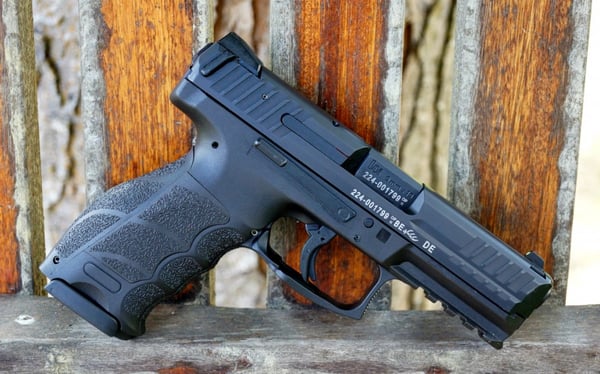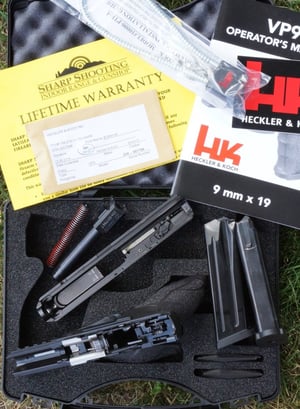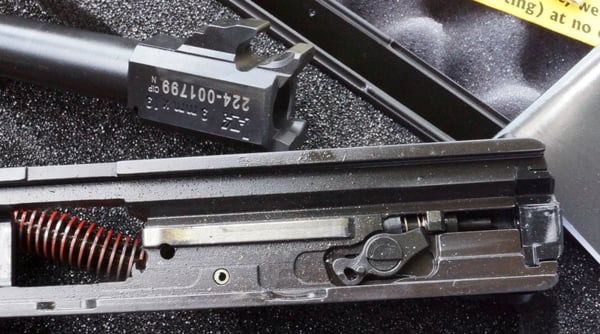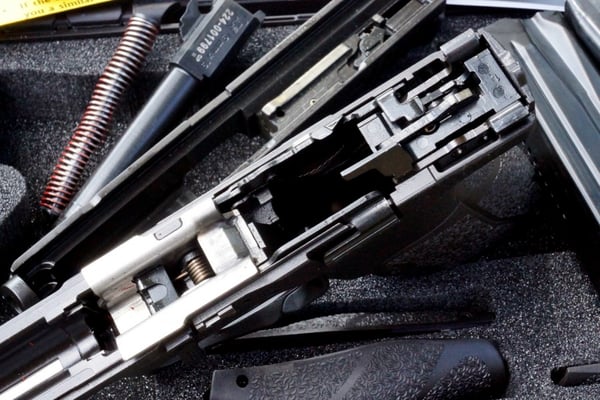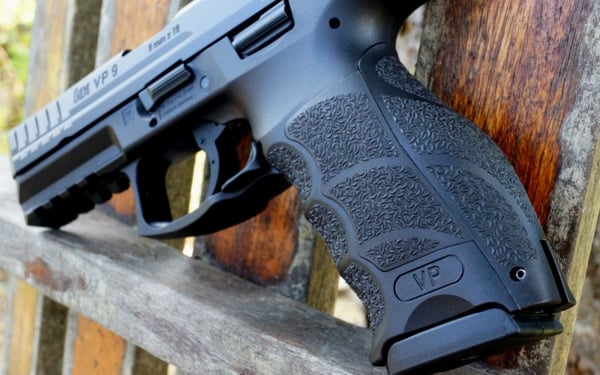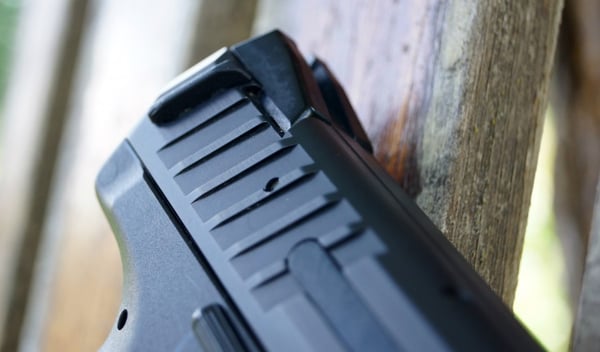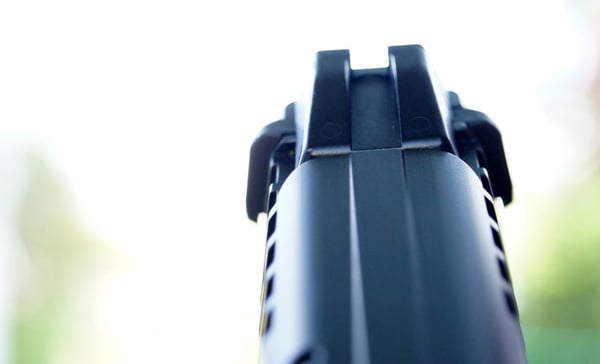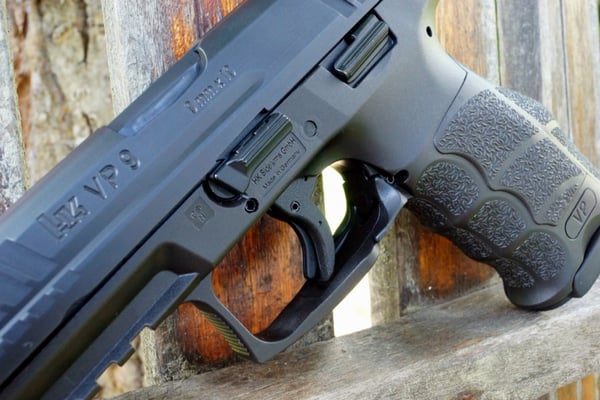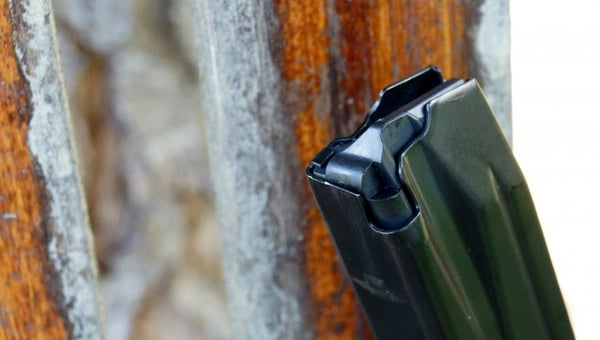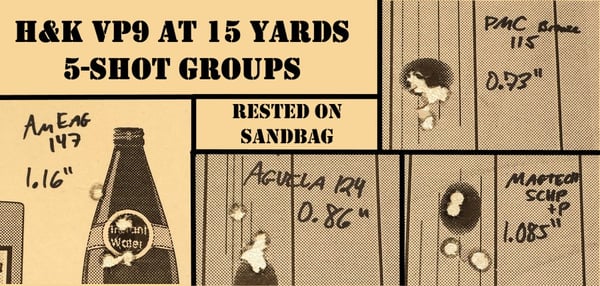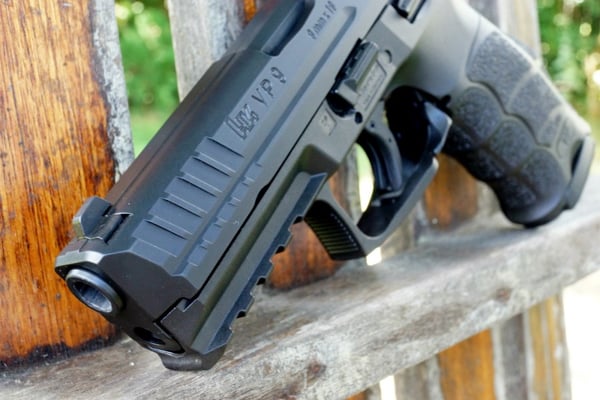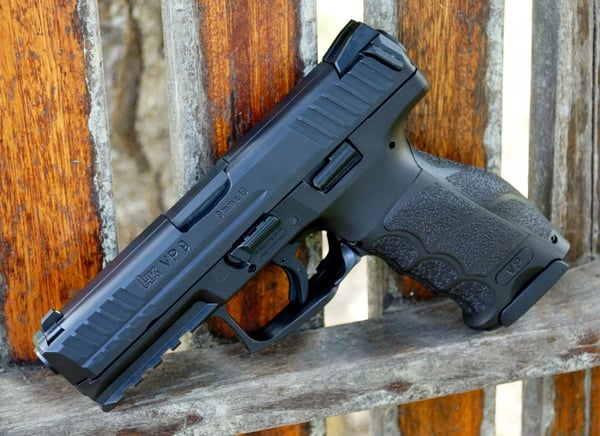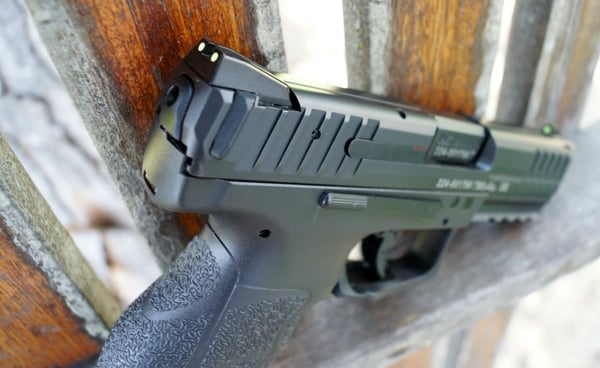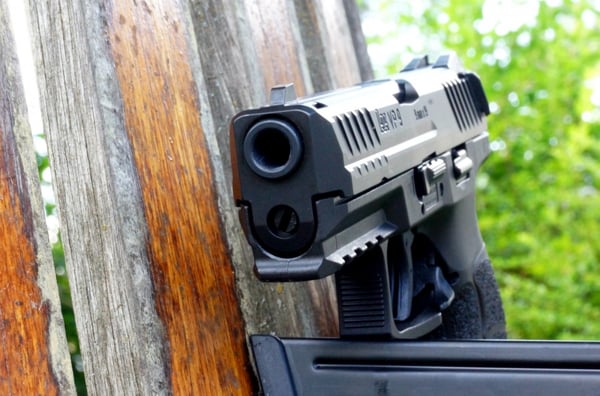Gun Review: Heckler & Koch VP9
HK is no stranger to striker-fired pistols, but it's been a while since they've designed a new one -- close to four decades. With the VP9 hot off the presses, the wait is over and Heckler & Koch has reentered the striker-fired handgun market. This bad boy is sort of like a cross between HK's own P30 and Walther's PPQ, with a trick or two of its own thrown in for good measure . . .
In The Box
HK's VP9 effectively puts a newly-designed slide on top of a P30 frame. It uses the 15-round magazines from the P30, and it comes with two of those in the black plastic case along with small, medium, and large backstraps and side panels, a magazine loader, owner's manual, fired case, decal, and HK gun lock. Laser cut foam ensures that everything has its place.
Like the rest of the HK pistol line, the VP9 sports a cold hammer forged barrel with polygonal rifling. GLOCK might be known for being definitively un-groovy, but H&K did it first with the P7. (edit: first pistol w/ polygonal rifling may have been HK's P9, actually)
As you'd expect, that barrel drops into the steel slide and locks up Browning short-recoil style with a linkless cam. A flat-wire recoil spring is captured by a steel guide rod. The rotating striker block is pretty interesting -- I think the HK P7 works similarly.
I dig the beefy steel inserts in the reinforced polymer frame and the thick metal parts in general. There's decent rail real estate and some stout lugs, including the disassembly lever lug that you can see rotated 90* clockwise in the photo above, which allows the slide to slide off the front. Heckler & Koch certainly has a reputation for reliability, and this pistol looks tough.
Ergos
More or less identical to the HK P30 frame, the VP9 feels amazing in the hand. I love this grip texture. There's a ton of similarity between this pistol and the Walther PPQ, and my thoughts about the PPQ being one of the nicest-to-grip guns out there carries right over to the VP9 here. I mean they are really, really similar.
Actually, the VP9 is more similar to the first generation of PPQ since they both employ trigger guard-located, paddle magazine release levers. These are great because they are fully ambidextrous and can be easily activated by your strong or support hand, while likely being less likely to get activated accidently. We aren't really used to this in the U.S. though, and it takes some training to become proficient and to choose your lever press method of choice, as options include strong hand thumb, index finger, or middle finger as well as support hand digits.
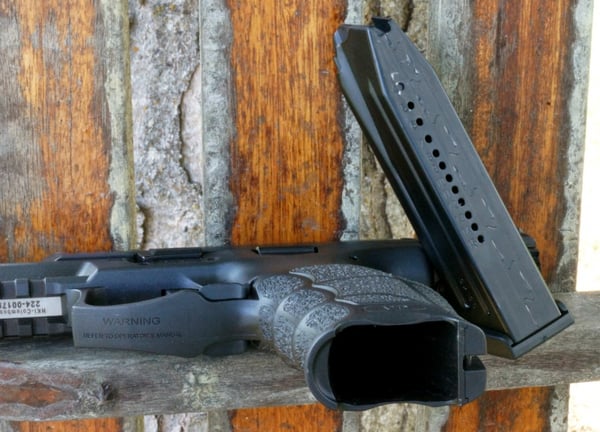
HK takes grip customization a step further than the norm by offering not only interchangeable backstraps, but side panels as well. S, M, and L for both mean you can alter the front-to-rear size and shape (backstrap 'hump') as well as the palm swell width. Swapping any of these requires driving out a pin in the butt of the grip. This allows the backstrap to slide down and unlock, which, once removed from the frame, allows the side panels to slide rearwards off of their grooves and off the frame as well. Any size backstrap can be mated with any size side panels, and you can even run a thicker side panel on one side vs. the other -- dream big, don't limit yourself.
The slide catch lever is extended towards the rear of the pistol as on many of HK's other offerings (and on the PPQ), but on the VP9 that extension happens inside of the frame. Well, at least on the left side. This leaves a more or less standard-sized lever on that side of the gun, while on the right side the lever runs outside of the frame. That one's nice and flush with the frame, though, so it shouldn't get in your way while still offering ambidextrous operation of the only shooting control other than the mag release. That is to say there's no manual safety like you'll find on most other HK pistols.
One feature by which the VP9 really does differentiate itself is what HK calls "charging supports." These polymer ears on the rear of the slide give you a little something extra to grab onto when racking or otherwise manipulating it. The interwebs chatter makes these seem a little controversial, but I gotta tell you, they do work. Whether you're a fan of pinching the slide between thumb and forefinger or grabbing over the top, these little tabs give you extra purchase and make accidently slipping off the back really hard to do. They also provide a solid, tactile reference point. I'm sure they'll be a big help to anyone with limited hand/grip strength.
Although they barely add thickness to the pistol -- considering they don't stick out farther than some of the controls -- if they aren't your cup of tea they can be removed. Drift the rear sight off, lift the polymer piece out the top, and put the sight back on.
Sights
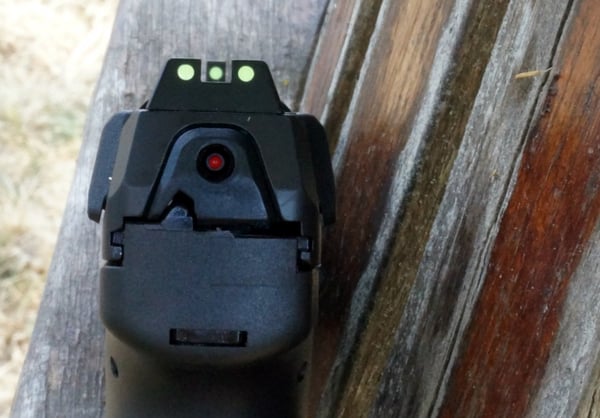 THE RED STRIKER TIP IS VISIBLE THROUGH A HOLE IN THE SLIDE PLATE WHEN THE STRIKER IS COCKED
THE RED STRIKER TIP IS VISIBLE THROUGH A HOLE IN THE SLIDE PLATE WHEN THE STRIKER IS COCKED
Glow-in-the-dark (must be charged by a light source), 3-dot sights are standard and Tritium sights are optional or sold separately. I found the bright green-ish dots to be crisp, clean and easy to see. The shape and sharp edges of the sights made alignment easy, and the width of the rear notch vs. the width of the front blade struck a pretty good balance between tactical/defensive (lots of light on either side of the front blade for quicker acquisition) and target (less light for ease of more precise alignment).
Trigger
While much better than the vast majority of the striker-fired market, this is the one category in which the VP9 can't match the PPQ. The trigger stroke is a bit longer, there's a bit more creep, and the reset is longer while also being a bit softer.
To be clear, it's a very good trigger for a striker-fired pistol. Like the PPQ, the VP9 is single action in the true sense of the term. Pulling the trigger serves only to release the striker, which is already fully cocked by the cycling of the slide. This is in contrast to the majority of striker-fired pistols on the market where the trigger pull must first cock or finish cocking the striker before releasing it. In theory this could leave the VP9 with a 1911-like, super short, light, and crisp trigger, but in practice that isn't the case ("In theory, practice is the same as theory"). Clearing the striker block safety requires extra trigger travel, and there's plenty of sear engagement here that adds just a touch of creep.
The trigger on my VP9 rental loaner measured very consistently at 5.4 to 5.5 lbs every time, which is right in-line with HK's published weight of 5.4 lbs. I have absolutely no issue with this weight at all, but must say that I shot the 4.75 lb PPQ trigger better. Some (or even most) of that was probably also due to the crisper, shorter nature of the PPQ's bang switch.
Magazines
High-quality, made in Germany. Interesting construction with the 'zipper' assembly down the back (see 2nd photo in "Ergos" section). The mags accept all 15 rounds without complaint; the last one inserting with no problem. Wide base pads combined with indentations at the bottom of the grip allow you to get a solid purchase to strip out the magazine if needed, but under normal conditions they spring right out of there.
I do have two magazine-related gripes, though:
Corners. The business end of these mags is covered in 90* corners. The feed lips poke your dang thumb. Regardless of the crap I'm going to get in the comments for whining about it, it would be a mistake not to point it out. I don't think I've loaded up a pistol magazine before that was so tough on the thumbs. At least not a new one that hasn't been worn sharp somewhere.
Magazine well. One more trip up to that 2nd photo in the "Ergos" section again. There's no bevel. The edges all around the magwell are more 90* corners. Despite the taper at the top of the magazine I still found myself getting caught up on an edge of the magwell sometimes. I'm sure I'd figure it out with more time spent behind the VP9, but, you know, it's no Jet Funnel. A few years ago I wouldn't have thought much of this, but I'm coming to expect some degree of taper/bevel on new pistols.
Disassembly
Lock the slide back, rotate the takedown lever, then remove the slide off the front of the frame. No trigger pull is required.
Accuracy
From a sandbag rest at 15 yards, the VP9 turned in some pretty darn solid, 5-shot groups:
On The Range
The VP9 feels good in the hand, points naturally, and shoots pretty softly. The sights are quick to pick up and align on target. Balance is good and slide manipulation is easy -- especially with those charging supports in addition to front and rear serrations.
With a slightly slimmer and smaller slide catch, I didn't find myself blocking its ability to move upwards as often as I did on the PPQ. However, it still happened. I just love to ride my thumb on that area of the frame -- muscle memory from riding the safety on my competition pistol -- and it only takes a tiny amount of pressure to prevent it from locking the slide back. As in the PPQ, this really wouldn't be a problem if it was your go-to pistol since you'd learn around it, but for my purposes these extra-rearward slide catches are in the wrong place. Of course, they're easy to reach so I understand the design intention.
Despite excellent mechanical accuracy, when fooling around on the range I didn't shoot this gun as accurately as the PPQ. The difference there is the trigger. I think I was anticipating the VP9's break a little, whereas the PPQ's trigger is so short and crisp that I couldn't screw up. Again though, the VP9 still has a great trigger and I still shot it very well.
Reliability is there. This rental gun already had 600-700 flawless rounds through it, according to the range, and I put another 250 through it on two outings. The vast majority of what I shot were minimum power factor reloads, but it also ate some factory ammo in varying weights and a mag's worth of assorted hollow points. Nary a hitch, and the thing still looks brand new as it approaches the 1k rounds mark.
Conclusions
People will buy this HK for tactical/defensive purposes and the PPQ for target shooting purposes. It's just the image of the companies, I suppose. After all, HK has those spec ops contracts. While I think the VP9 is a freakin' sweet gun that will last a lifetime, is an awesome shooter, and is well-priced (at least for Heckler & Koch), I like the PPQ more and I'd lament anyone's choice to purchase this pistol without also trying a PPQ. Either pistol is just as well-suited for hard use, but the PPQ's trigger helps it excel on the range.
Of course, aesthetics are different and I did find the PPQ to have just a tad more muzzle flip. And the VP9 has wings.
Specifications: Heckler & Koch VP9
Caliber: 9x19
Capacity: 15+1
Barrel Length: 4.09"
Overall Length: 7.34"
Height: 5.41"
Width: 1.32"
Weight w/ Empty Magazine: 25.56 oz (mag weighs 3.28 oz)
MSRP: $719 (I've already seen them on sale for as low as $589.99)
Ratings (Out of Five Stars):
Accuracy: * * * * *
Highly accurate for a compact (errr, "duty-sized") pistol.
Ergonomics: * * * * *
Hard to improve on this. Grip shape, texture, and configuration options are top of the game.
Reliability: * * * * *
Although a pretty new design, all indications point to this pistol continuing HK's solid reputation for reliability and quality.
Trigger: * * * *
Really good for a striker-fired gun. Well above average. Not as good as the PPQ.
Customization: * * * 1/2
Grip customization is great. Full Pic rail opens up accessory options. The VP9 is new to the market, though, so things like sights, holsters, trigger mods, etc will have to catch up and it falls well short in aftermarket options compared to the GLOCKs of the world.
Overall: * * * *
The VP9 rocks. I just like the PPQ one star better.



